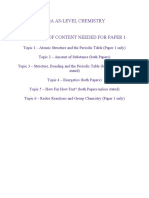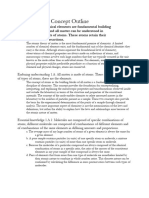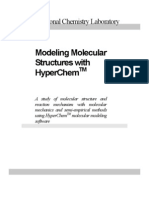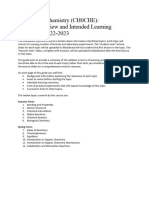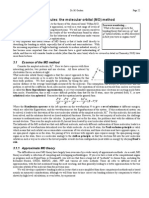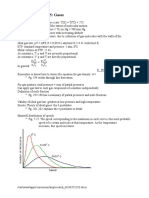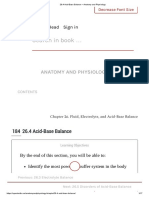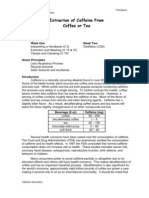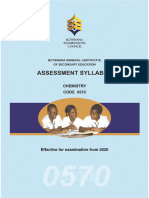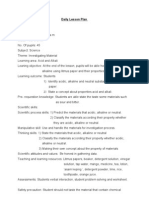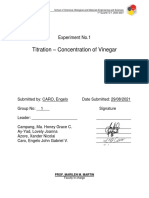0 ratings0% found this document useful (0 votes)
82 viewsAQA Chemistry - 7404/7405: 3.1 Physical Chemistry (AS Level)
AQA Chemistry - 7404/7405: 3.1 Physical Chemistry (AS Level)
Uploaded by
Louise Amoah1. The document outlines the key concepts in physical chemistry covered in an AS level chemistry course, including atomic structure, amounts of substance, bonding, energetics, and kinetics.
2. It describes various models of atomic structure that have been developed over time and how mass spectrometry can be used to analyze atomic structure.
3. Formulas for calculating relative atomic mass, relative molecular mass, moles, concentrations, and ideal gas behavior are defined. Bonding theories including ionic, covalent, metallic and intermolecular forces are also summarized.
Copyright:
© All Rights Reserved
Available Formats
Download as PDF, TXT or read online from Scribd
AQA Chemistry - 7404/7405: 3.1 Physical Chemistry (AS Level)
AQA Chemistry - 7404/7405: 3.1 Physical Chemistry (AS Level)
Uploaded by
Louise Amoah0 ratings0% found this document useful (0 votes)
82 views13 pages1. The document outlines the key concepts in physical chemistry covered in an AS level chemistry course, including atomic structure, amounts of substance, bonding, energetics, and kinetics.
2. It describes various models of atomic structure that have been developed over time and how mass spectrometry can be used to analyze atomic structure.
3. Formulas for calculating relative atomic mass, relative molecular mass, moles, concentrations, and ideal gas behavior are defined. Bonding theories including ionic, covalent, metallic and intermolecular forces are also summarized.
Original Title
Physical-revision-checklist
Copyright
© © All Rights Reserved
Available Formats
PDF, TXT or read online from Scribd
Share this document
Did you find this document useful?
Is this content inappropriate?
1. The document outlines the key concepts in physical chemistry covered in an AS level chemistry course, including atomic structure, amounts of substance, bonding, energetics, and kinetics.
2. It describes various models of atomic structure that have been developed over time and how mass spectrometry can be used to analyze atomic structure.
3. Formulas for calculating relative atomic mass, relative molecular mass, moles, concentrations, and ideal gas behavior are defined. Bonding theories including ionic, covalent, metallic and intermolecular forces are also summarized.
Copyright:
© All Rights Reserved
Available Formats
Download as PDF, TXT or read online from Scribd
Download as pdf or txt
0 ratings0% found this document useful (0 votes)
82 views13 pagesAQA Chemistry - 7404/7405: 3.1 Physical Chemistry (AS Level)
AQA Chemistry - 7404/7405: 3.1 Physical Chemistry (AS Level)
Uploaded by
Louise Amoah1. The document outlines the key concepts in physical chemistry covered in an AS level chemistry course, including atomic structure, amounts of substance, bonding, energetics, and kinetics.
2. It describes various models of atomic structure that have been developed over time and how mass spectrometry can be used to analyze atomic structure.
3. Formulas for calculating relative atomic mass, relative molecular mass, moles, concentrations, and ideal gas behavior are defined. Bonding theories including ionic, covalent, metallic and intermolecular forces are also summarized.
Copyright:
© All Rights Reserved
Available Formats
Download as PDF, TXT or read online from Scribd
Download as pdf or txt
You are on page 1of 13
At a glance
Powered by AI
This passage discusses various topics in physical chemistry including atomic structure, amount of substance, bonding, equilibria and electrochemistry.
An atom consists of protons, neutrons and electrons. The number of protons defines the element and is known as the atomic number. Isotopes exist which have the same number of protons but different numbers of neutrons.
The relative molecular mass can be determined from isotopic abundance data using mass spectrometry. It is also related to the molar mass which can be used to calculate amounts in moles from mass and vice versa.
AQA Chemistry – 7404/7405
3.1 Physical Chemistry (AS level)
You should be able to demonstrate and show your Progress and
understanding of: understanding:
1 2 3 4
3.1.1 Atomic structure
Appreciate that knowledge and understanding of atomic
structure has evolved over time.
Protons, neutrons and electrons: relative charge and
relative mass.
An atom consists of a nucleus containing protons and
neutrons surrounded by electrons.
Mass number (A) and atomic (proton) number (Z).
Students should be able to:
determine the number of fundamental particles in
atoms and ions using mass number, atomic number
and charge
explain the existence of isotopes.
The principles of a simple time of flight (TOF) mass
spectrometer, limited to ionisation, acceleration to give
all ions constant kinetic energy, ion drift, ion detection,
data analysis.
The mass spectrometer gives accurate information about
relative isotopic mass and also about the relative
abundance of isotopes.
Mass spectrometry can be used to identify elements and
determine the relative molecular mass.
Students should be able to:
interpret simple mass spectra of elements
calculate relative atomic mass from isotopic
abundance, limited to mononuclear ions.
Electron configurations of atoms and ions up to Z = 36 in
terms of shells and sub-shells (orbitals) s, p and d.
Ionisation energies.
Students should be able to:
define first ionisation energy
write equations for first and successive ionisation
energies
explain how first and successive ionisation
energies in Period 3 (Na–Ar) and in Group 2 (Be–
Ba) give evidence for electron configuration in
sub-shells and in shells.
3.1.2 Amount of substance
Relative atomic mass and relative molecular mass in
terms of 12C.
The term relative formula mass will be used for ionic
compounds.
Students should be able to:
define relative atomic mass (Ar)
define relative molecular mass (Mr).
The Avogadro constant as the number of particles in a
mole. The mole as applied to electrons, atoms, molecules,
ions, formulas and equations.
The concentration of a substance in solution, measured
in mol dm–3.
Students should be able to carry out calculations:
using the Avogadro constant
using mass of substance, Mr, and amount in moles
using concentration, volume and amount of
substance in a solution.
Students will not be expected to recall the value of the Avogadro constant.
The ideal gas equation pV = nRT with the variables in SI
units. Students should be able to use the equation in
calculations.
Students will not be expected to recall the value of the gas constant, R.
Empirical formula is the simplest whole number ratio of
atoms of each element in a compound.
Molecular formula is the actual number of atoms of each
element in a compound.
The relationship between empirical formula and
molecular formula.
Students should be able to:
calculate empirical formula from data giving
composition by mass or percentage by mass
calculate molecular formula from the empirical
formula and relative molecular mass.
Equations (full and ionic).
Percentage atom economy is:
× 100
Economic, ethical and environmental advantages for
society and for industry of developing chemical
processes with a high atom economy.
Students should be able to:
write balanced equations for reactions studied
balance equations for unfamiliar reactions when
reactants and products are specified.
Students should be able to use balanced equations to
calculate:
masses
volumes of gases
percentage yields
percentage atom economies
concentrations and volumes for reactions in
solutions.
Required practical 1
Make up a volumetric solution and carry out a simple
acid–base titration.
3.1.3 Bonding
Ionic bonding involves electrostatic attraction between
oppositely charged ions in a lattice.
The formulas of compound ions, eg sulfate, hydroxide,
nitrate, carbonate and ammonium.
Students should be able to:
predict the charge on a simple ion using the
position of the element in the Periodic Table
construct formulas for ionic compounds.
A single covalent bond contains a shared pair of
electrons and multiple bonds contain multiple pairs of
electrons.
A co-ordinate (dative covalent) bond contains a shared
pair of electrons with both electrons supplied by one
atom.
Students should be able to represent:
a covalent bond using a line
a co-ordinate bond using an arrow.
Metallic bonding involves attraction between delocalised
electrons and positive ions arranged in a lattice.
The four types of crystal structure:
ionic
metallic
macromolecular (giant covalent)
molecular.
The structures of the following crystals as examples of
these four types of crystal structure:
diamond
graphite
ice
iodine
magnesium
sodium chloride.
Students should be able to:
relate the melting point and conductivity of
materials to the type of structure and the
bonding present
explain the energy changes associated with
changes of state
draw diagrams to represent these structures
involving specified numbers of particles.
Bonding pairs and lone (non-bonding) pairs of electrons
as charge clouds that repel each other.
Pairs of electrons in the outer shell of atoms arrange
themselves as far apart as possible to minimise repulsion.
Lone pair–lone pair repulsion is greater than lone pair–
bond pair repulsion, which is greater than bond pair–bond
pair repulsion.
The effect of electron pair repulsion on bond angles.
Students should be able to explain the shapes of, and
bond angles in, simple molecules and ions with up to six
electron pairs (including lone pairs of electrons)
surrounding the central atom.
Electronegativity as the power of an atom to attract the
pair of electrons in a covalent bond.
The electron distribution in a covalent bond between
elements with different electronegativities will be
unsymmetrical. This produces a polar covalent bond, and
may cause a molecule to have a permanent dipole.
Students should be able to:
use partial charges to show that a bond is polar
explain why some molecules with polar bonds do
not have a permanent dipole.
Forces between molecules:
permanent dipole–dipole forces
induced dipole–dipole (van der Waals, dispersion,
London) forces
hydrogen bonding.
The melting and boiling points of molecular substances
are influenced by the strength of these intermolecular
forces.
The importance of hydrogen bonding in the low density
of ice and the anomalous boiling points of compounds.
Students should be able to:
explain the existence of these forces between
familiar and unfamiliar molecules
explain how melting and boiling points are
influenced by these intermolecular forces.
3.1.4 Energetics
Reactions can be endothermic or exothermic.
Enthalpy change (∆H) is the heat energy change
measured under conditions of constant pressure.
Standard enthalpy changes refer to standard conditions,
ie 100 kPa and a stated temperature (eg ∆H298Ɵ).
Students should be able to:
define standard enthalpy of combustion (∆cHƟ)
define standard enthalpy of formation (∆fHƟ).
The heat change, q, in a reaction is given by the equation
q = mc∆T, where m is the mass of the substance that
has a temperature change ∆T and a specific heat
capacity c.
Students should be able to:
use this equation to calculate the molar enthalpy
change for a reaction
use this equation in related calculations.
Students will not be expected to recall the value of the specific heat capacity, c, of
a substance.
Required practical 2
Measurement of an enthalpy change.
Hess’s law.
Students should be able to use Hess’s law to perform
calculations, including calculation of enthalpy changes for
reactions from enthalpies of combustion or from
enthalpies of formation.
Mean bond enthalpy.
Students should be able to:
define the term mean bond enthalpy
use mean bond enthalpies to calculate an
approximate value of ∆H for reactions in the
gaseous phase
explain why values from mean bond enthalpy
calculations differ from those determined using
Hess’s law.
3.1.5 Kinetics
Reactions can only occur when collisions take place
between particles having sufficient energy; this energy
is called the activation energy.
Students should be able to:
define the term activation energy
explain why most collisions do not lead to a
reaction.
Maxwell–Boltzmann distribution of molecular energies in
gases. Students should be able to draw and interpret
distribution curves for different temperatures.
Meaning of the term rate of reaction.
The qualitative effect of temperature changes on the
rate of reaction.
The qualitative effect of changes in concentration or in
the pressure on collision frequency.
Students should be able to explain how a change in
concentration or a change in pressure influences the
rate of a reaction.
A catalyst is a substance that increases the rate of a
chemical reaction without being changed in chemical
composition or amount. Catalysts work by providing an
alternative reaction route of lower activation energy.
Students should be able to:
use the Maxwell–Boltzmann distribution to explain
why a small temperature increase can lead to a
large increase in rate.
use a Maxwell–Boltzmann distribution to help
explain how a catalyst increases the rate of a
reaction involving a gas.
Required practical 3
Investigation of how the rate of a reaction changes with
temperature.
3.1.6 Chemical equilibria, Le Chatelier’s principle and Kc
Many chemical reactions are reversible. In a reversible
reaction at equilibrium:
forward and reverse reactions proceed at equal
rates
the concentrations of reactants and products
remain constant
Le Chatelier’s principle.
Le Chatelier's principle can be used to predict the
effects of changes in temperature, pressure and
concentration on the position of equilibrium in
homogeneous reactions.
A catalyst does not affect the position of equilibrium.
Students should be able to:
use Le Chatelier’s principle to predict
qualitatively the effect of changes in
temperature, pressure and concentration on the
position of equilibrium
explain why, for a reversible reaction used in an
industrial process, a compromise temperature and
pressure may be used.
The equilibrium constant Kc is deduced from the equation
for a reversible reaction.
The concentration, in mol dm–3, of a species X involved in
the expression for Kc is represented by [X].
The value of the equilibrium constant is not affected
either by changes in concentration or addition of a
catalyst.
Students should be able to:
construct an expression for Kc for a homogeneous
system in equilibrium
calculate a value for Kc from the equilibrium
concentrations for a homogeneous system at
constant temperature
perform calculations involving Kc
predict the qualitative effects of changes of
temperature on the value of Kc
3.1.7 Oxidation, reduction and redox equations
Oxidation is the process of electron loss and oxidising
agents are electron acceptors.
Reduction is the process of electron gain and reducing
agents are electron donors.
The rules for assigning oxidation states.
Students should be able to:
work out the oxidation state of an element in a
compound or ion from the formula
write half-equations identifying the oxidation and
reduction processes in redox reactions
combine half-equations to give an overall redox
equation.
AQA Chemistry – 7404/7405
3.1 Physical Chemistry (A-level only)
You should be able to demonstrate and show your Progress and
understanding of: understanding:
1 2 3 4
3.1.8 Thermodynamics (A-level)
Lattice enthalpy can be defined as either enthalpy of
lattice dissociation or enthalpy of lattice formation.
Born–Haber cycles are used to calculate lattice
enthalpies using the following data:
enthalpy of formation
ionisation energy
enthalpy of atomisation
bond enthalpy
electron affinity.
Students should be able to:
define each of the above terms and lattice
enthalpy
construct Born–Haber cycles to calculate lattice
enthalpies using these enthalpy changes
construct Born–Haber cycles to calculate one of
the other enthalpy changes
compare lattice enthalpies from Born–Haber
cycles with those from calculations based on a
perfect ionic model to provide evidence for
covalent character in ionic compounds.
Cycles are used to calculate enthalpies of solution for
ionic compounds from lattice enthalpies and enthalpies
of hydration.
Students should be able to:
define the term enthalpy of hydration
perform calculations of an enthalpy change using
these cycles.
∆H, whilst important, is not sufficient to explain
feasible change.
The concept of increasing disorder (entropy change,
∆S).
∆S accounts for the above deficiency, illustrated by
physical changes and chemical changes. The balance
between entropy and enthalpy determines the feasibility
of a reaction given by the relationship:
∆G = ∆H – T∆S (derivation not required).
For a reaction to be feasible, the value of ∆G must be
zero or negative.
Students should be able to:
calculate entropy changes from absolute entropy
values
use the relationship ∆G = ∆H – T∆S to determine
how ∆G varies with temperature
use the relationship ∆G = ∆H – T∆S to determine
the temperature at which a reaction becomes
feasible.
3.1.9 Rate equations (A-level only)
The rate of a chemical reaction is related to the
concentration of reactants by a rate equation of the
form:
Rate = k[A]m [B]n
where m and n are the orders of reaction with respect
to reactants A and B and k is the rate constant. The
orders m and n are restricted to the values 0, 1, and 2.
The rate constant k varies with temperature as shown by
the equation:
𝑘 = 𝐴𝑒
where A is a constant, known as the Arrhenius constant,
Ea is the activation energy and T is the temperature in K.
Students should be able to:
define the terms order of reaction and rate
constant
perform calculations using the rate equation
explain the qualitative effect of changes in
temperature on the rate constant k
perform calculations using the equation 𝑘 = 𝐴𝑒
understand that the equation 𝑘 = 𝐴𝑒 can be
rearranged into the form ln 𝑘 = − + ln 𝐴 and
know how to use this rearranged equation with
experimental data to plot a straight line graph
with slope −
These equations and the gas constant, R, will be given when required.
The rate equation is an experimentally determined
relationship.
The orders with respect to reactants can provide
information about the mechanism of a reaction.
Students should be able to:
use concentration–time graphs to deduce the rate
of a reaction
use initial concentration–time data to deduce the
initial rate of a reaction
use rate–concentration data or graphs to deduce
the order (0, 1 or 2) with respect to a reactant
derive the rate equation for a reaction from the
orders with respect to each of the reactants
use the orders with respect to reactants to
provide information about the rate
determining/limiting step of a reaction.
Required practical 7
Measuring the rate of reaction:
by an initial rate method
by a continuous monitoring method.
3.1.10 Equilibrium constant Kp for homogeneous systems (A-
level only)
The equilibrium constant Kp is deduced from the equation
for a reversible reaction occurring in the gas phase.
Kp is the equilibrium constant calculated from partial
pressures for a system at constant temperature.
Students should be able to:
derive partial pressure from mole fraction and
total pressure
construct an expression for Kp for a homogeneous
system in equilibrium
perform calculations involving Kp
predict the qualitative effects of changes in
temperature and pressure on the position of
equilibrium
predict the qualitative effects of changes in
temperature on the value of Kp
understand that, whilst a catalyst can affect the
rate of attainment of an equilibrium, it does not
affect the value of the equilibrium constant.
3.1.11 Electrode potentials and electrochemical cells (A-level
only)
IUPAC convention for writing half-equations for
electrode reactions.
The conventional representation of cells.
Cells are used to measure electrode potentials by
reference to the standard hydrogen electrode.
The importance of the conditions when measuring the
electrode potential, E (Nernst equation not required).
Standard electrode potential, EƟ, refers to conditions of
298 K, 100 kPa and 1.00 mol dm−3 solution of ions.
Standard electrode potentials can be listed as an
electrochemical series.
Students should be able to:
use EƟ values to predict the direction of simple
redox reactions
calculate the EMF of a cell
write and apply the conventional representation
of a cell.
Required practical 8
Measuring the EMF of an electrochemical cell.
Electrochemical cells can be used as a commercial source
of electrical energy.
The simplified electrode reactions in a lithium cell:
Positive electrode: Li+ + CoO2 + e– → Li+[CoO2]–
Negative electrode: Li → Li+ + e–
Cells can be non-rechargeable (irreversible),
rechargeable or fuel cells.
Fuel cells are used to generate an electric current and
do not need to be electrically recharged.
The electrode reactions in an alkaline hydrogen–oxygen
fuel cell.
The benefits and risks to society associated with using
these cells.
Students should be able to:
use given electrode data to deduce the reactions
occurring in non-rechargeable and rechargeable
cells
deduce the EMF of a cell
explain how the electrode reactions can be used
to generate an electric current.
3.1.12 Acids and bases (A-level only)
An acid is a proton donor.
A base is a proton acceptor.
Acid–base equilibria involve the transfer of protons.
The concentration of hydrogen ions in aqueous solution
covers a very wide range. Therefore, a logarithmic scale,
the pH scale, is used as a measure of hydrogen ion
concentration:
pH = –log10[H+]
Students should be able to:
convert concentration of hydrogen ions into pH
and vice versa
calculate the pH of a solution of a strong acid
from its concentration.
Water is slightly dissociated.
Kw = [H+][OH–]
Kw is derived from the equilibrium constant for this
dissociation. The value of Kw varies with temperature.
Students should be able to use Kw to calculate the pH of
a strong base from its concentration.
Weak acids and weak bases dissociate only slightly in
aqueous solution.
Ka is the dissociation constant for a weak acid.
pKa = –log10 Ka
Students should be able to:
construct an expression for Ka
perform calculations relating the pH of a weak
acid to the concentration of the acid and the
dissociation constant, Ka
convert Ka into pKa and vice versa.
Titrations of acids with bases.
Students should be able to perform calculations for
these titrations based on experimental results.
Typical pH curves for acid–base titrations in all
combinations of weak and strong monoprotic acids and
bases.
Students should be able to:
sketch and explain the shapes of typical pH
curves
use pH curves to select an appropriate indicator.
Required practical 9
Investigate how pH changes when a weak acid reacts
with a strong base and when a strong acid reacts with a
weak base.
A buffer solution maintains an approximately constant
pH, despite dilution or addition of small amounts of acid
or base.
Acidic buffer solutions contain a weak acid and the salt
of that weak acid.
Basic buffer solutions contain a weak base and the salt
of that weak base.
Applications of buffer solutions.
Students should be able to:
explain qualitatively the action of acidic and basic
buffers
calculate the pH of acidic buffer solutions.
You might also like
- CHEM35.1 E1 Extraction of Caffeine From CoffeeDocument4 pagesCHEM35.1 E1 Extraction of Caffeine From CoffeeGlenn Vincent Tumimbang83% (6)
- Chemistry A level SpecDocument32 pagesChemistry A level SpecUserNo ratings yet
- Paper 1 Summary For AsDocument11 pagesPaper 1 Summary For AsElastic FantasticNo ratings yet
- Year 12 Chemistry CurriculumDocument12 pagesYear 12 Chemistry Curriculumswagxz.jNo ratings yet
- Learning Objectives As91390Document2 pagesLearning Objectives As91390api-252561013No ratings yet
- 1 Aqa ChemistryDocument50 pages1 Aqa Chemistryoliviaojemen15No ratings yet
- 1048647970PLC - DP Chemistry checklist (1)Document15 pages1048647970PLC - DP Chemistry checklist (1)Ksujatha BgNo ratings yet
- A-Level Chemistry Revision: Cheeky Revision ShortcutsFrom EverandA-Level Chemistry Revision: Cheeky Revision ShortcutsRating: 4 out of 5 stars4/5 (5)
- Practice - Worksheet Chemistry - XIDocument6 pagesPractice - Worksheet Chemistry - XIakshitksingh2007No ratings yet
- AP Chemistry Study GuideDocument91 pagesAP Chemistry Study Guide1026036No ratings yet
- AP Chemistry - Study GuideDocument79 pagesAP Chemistry - Study GuideRaabiah AzeezNo ratings yet
- 9701-2022-2024-Syllabus CHEMISTRYDocument36 pages9701-2022-2024-Syllabus CHEMISTRYaliahmedrana1No ratings yet
- Transcript of IB Chemistry Mind MapDocument8 pagesTranscript of IB Chemistry Mind MapJayakumar SankaranNo ratings yet
- Revision Units 1 & 2Document3 pagesRevision Units 1 & 2Syed Abdul Rehman ShahNo ratings yet
- C1H GCSE ChemistryDocument22 pagesC1H GCSE ChemistryjcksnbrclyNo ratings yet
- CAPE Chemistry U1 - Breakdown of SyllabusDocument24 pagesCAPE Chemistry U1 - Breakdown of SyllabusJevon SiddonNo ratings yet
- ChemistryDocument25 pagesChemistrymariabour.enNo ratings yet
- AP Chemistry Concept OutlineDocument51 pagesAP Chemistry Concept Outlinehylee102594No ratings yet
- C1 SYLLABUS CONTENT Atomic Structure and Periodic Table CHEMISTRYDocument6 pagesC1 SYLLABUS CONTENT Atomic Structure and Periodic Table CHEMISTRYAdnan BukhariNo ratings yet
- Molecular Modeling by Roxie AllenDocument5 pagesMolecular Modeling by Roxie AllenPaul SchumannNo ratings yet
- AQA Chemistry Subject Content Physical ChemistryDocument1 pageAQA Chemistry Subject Content Physical ChemistryImtinan HusseinNo ratings yet
- Force FieldsDocument7 pagesForce FieldsSoumya JainNo ratings yet
- Passing Package Chemistry 11Document37 pagesPassing Package Chemistry 11kaka849296No ratings yet
- 05 Molecular Geometry and Bonding TheoriesDocument16 pages05 Molecular Geometry and Bonding TheoriesChrissa GuicoNo ratings yet
- NotesDocument8 pagesNotesMayankNo ratings yet
- CHM1045Document8 pagesCHM1045lunamariadiazcNo ratings yet
- CHEM 0100 Course OutlineDocument8 pagesCHEM 0100 Course OutlineAkisha Ali-KhanNo ratings yet
- Modeling Molecular Structures With Hyperchem: Computational Chemistry LaboratoryDocument13 pagesModeling Molecular Structures With Hyperchem: Computational Chemistry LaboratorySwarali KamathNo ratings yet
- Foundation Chemistry Overview 22-23Document13 pagesFoundation Chemistry Overview 22-23coin09637No ratings yet
- Module 6: Physics of Semiconductor Devices Lecture 32: Bonding in SolidsDocument8 pagesModule 6: Physics of Semiconductor Devices Lecture 32: Bonding in SolidsddNo ratings yet
- Chemical Kinetics and Surface Chemistry: Dr. R. Manab Kundu Drr. Manab Kundu MDocument35 pagesChemical Kinetics and Surface Chemistry: Dr. R. Manab Kundu Drr. Manab Kundu MGreeshma GireeshNo ratings yet
- 3820 Lecture Chapter - 3 - Part1 - 2004 PDFDocument15 pages3820 Lecture Chapter - 3 - Part1 - 2004 PDFPhuongUblMyNo ratings yet
- CHEM1 - Foundation Chemistry Definitions To Learn: 1. Formulae & EquationsDocument5 pagesCHEM1 - Foundation Chemistry Definitions To Learn: 1. Formulae & EquationscsNo ratings yet
- Chem NotesDocument300 pagesChem NotesTeejay MakazhuNo ratings yet
- Atomic StructureDocument2 pagesAtomic StructureSana GargNo ratings yet
- SCH 1110 CHEMISTRY 1 NotesDocument86 pagesSCH 1110 CHEMISTRY 1 NotesIsaac Ogola100% (1)
- STC 111 PDFDocument34 pagesSTC 111 PDFogbonna ebuka innocentNo ratings yet
- Detailed Notes ELDocument29 pagesDetailed Notes ELNifemiNo ratings yet
- Honors Chemistry Mid-Term Review: What Is Matter?Document16 pagesHonors Chemistry Mid-Term Review: What Is Matter?Christie ZhangNo ratings yet
- NGSS Interpretation - HS Physical ScienceDocument8 pagesNGSS Interpretation - HS Physical ScienceLaurie ColemanNo ratings yet
- Topic 1 Atomic Structure and The Periodic TableDocument2 pagesTopic 1 Atomic Structure and The Periodic TableSam ShohetNo ratings yet
- Slo Review Standard 3Document1 pageSlo Review Standard 3api-305204604No ratings yet
- Gen Chem RebyuwerDocument11 pagesGen Chem Rebyuweryousef shalabyNo ratings yet
- Chemistry Quick Notes by MdcatAcademy - Com .Document51 pagesChemistry Quick Notes by MdcatAcademy - Com .RaviansNo ratings yet
- Chemistry AM 06: SyllabusDocument14 pagesChemistry AM 06: SyllabusBernice JohnsonNo ratings yet
- A2 Tick ListsDocument21 pagesA2 Tick ListsGirish AdapaNo ratings yet
- All FlashCards of 9701 Chemistry CAIE As LevelDocument1,308 pagesAll FlashCards of 9701 Chemistry CAIE As LevelAdam BeyNo ratings yet
- Definitions - Physical Chemistry I - AQA Chemistry A-LevelDocument9 pagesDefinitions - Physical Chemistry I - AQA Chemistry A-LevelÏt's RîçkgãrçīäNo ratings yet
- Organic Chemistry 1Document10 pagesOrganic Chemistry 10No ratings yet
- Syllabus Chemistry Cambridge OLDocument22 pagesSyllabus Chemistry Cambridge OLShanan GunawardenaNo ratings yet
- Ncert Important Chemistry Points-1 For Jee-Main 2023Document99 pagesNcert Important Chemistry Points-1 For Jee-Main 2023PrinceNo ratings yet
- 01 - AP Chemistry Unit 01 ReviewDocument8 pages01 - AP Chemistry Unit 01 ReviewtkimNo ratings yet
- Advances in Methods and Algorithms in A Modern Quantum Chemistry Program PackagewDocument20 pagesAdvances in Methods and Algorithms in A Modern Quantum Chemistry Program PackagewarbitkumarNo ratings yet
- M Topics Exam 2-Annotated-F14Document10 pagesM Topics Exam 2-Annotated-F14bluemoon4777No ratings yet
- Quiz 2 AnswersDocument6 pagesQuiz 2 Answerselliott.rillstoneNo ratings yet
- Standard Model 2Document42 pagesStandard Model 2Nhat MinhNo ratings yet
- Imp Points Grade 10 - 2024Document21 pagesImp Points Grade 10 - 2024Smarty ElephantNo ratings yet
- Safari - 15 Mar 2023 at 15:29Document1 pageSafari - 15 Mar 2023 at 15:29Mazvitaishe MudamburiNo ratings yet
- Bonding in Molecules 2019 2nd Yr Michaelmas TermDocument71 pagesBonding in Molecules 2019 2nd Yr Michaelmas Termtresa.george27No ratings yet
- Notes On Semiconductor Physics For Electronic DevicesDocument27 pagesNotes On Semiconductor Physics For Electronic DevicesspyseetunaNo ratings yet
- Lesson Plan COT HealthDocument143 pagesLesson Plan COT Healthjamesclyde.generaleNo ratings yet
- 26.4 Acid-Base Balance - Anatomy and PhysiologyDocument17 pages26.4 Acid-Base Balance - Anatomy and PhysiologyManjunath Vaddambal100% (1)
- Pretreatment ASSIGNMENTDocument64 pagesPretreatment ASSIGNMENTGkou DojkuNo ratings yet
- Goc Iit Jam MaterialDocument15 pagesGoc Iit Jam MaterialjagannivasNo ratings yet
- 12.3 Acids Bases and Salts Ms - Igcse Cie Chemistry - Ext Theory PaperDocument6 pages12.3 Acids Bases and Salts Ms - Igcse Cie Chemistry - Ext Theory Paperthemathscientist001No ratings yet
- Concept Map of Matter - VocabsDocument1 pageConcept Map of Matter - VocabsERVIN DANCANo ratings yet
- Week 4 AdvancedDocument19 pagesWeek 4 AdvancedAaron MostNo ratings yet
- Chemsheets KS3 066 Acids Bases 1Document1 pageChemsheets KS3 066 Acids Bases 1diya.hiraniNo ratings yet
- Them Sample PearsonDocument30 pagesThem Sample PearsonAysu'z Quirky EsseNo ratings yet
- Caffeine ExtractionDocument6 pagesCaffeine ExtractionSidney Liu 廖子彥No ratings yet
- Chemistry 10th TestDocument24 pagesChemistry 10th TestMohammad AshfaqNo ratings yet
- Experiment 32 Procedure ProposalDocument10 pagesExperiment 32 Procedure Proposalapi-333303583No ratings yet
- 0570 ChemistryDocument38 pages0570 ChemistryLornah LucyNo ratings yet
- Levelling and Differentiating SolventsDocument7 pagesLevelling and Differentiating SolventsChibuike CharlesNo ratings yet
- All Mcqs 2020 ChemDocument631 pagesAll Mcqs 2020 ChemContact AmsibNo ratings yet
- F325-01Jun15 104712Document24 pagesF325-01Jun15 104712Hassan Al-ubeidiNo ratings yet
- Sains RPHDocument6 pagesSains RPHMurugan MuruNo ratings yet
- Chemistry F4 AssignmentDocument18 pagesChemistry F4 AssignmentFazrul AminNo ratings yet
- Classification of AlkaloidsDocument8 pagesClassification of AlkaloidsJenelle Jane Quilaneta100% (1)
- Redox and Equivalent Concept Lecture 3 (14th December 2022) Handout and HomeworkDocument88 pagesRedox and Equivalent Concept Lecture 3 (14th December 2022) Handout and HomeworkanilpurnimakothariNo ratings yet
- ASRJC H2 Chem 2021 P1 SolutionsDocument29 pagesASRJC H2 Chem 2021 P1 Solutionsantesipation ฅ'ω'ฅNo ratings yet
- IIT JEE Main Advanced Physical Chemistry 12th Volumetric Analysis PDFDocument38 pagesIIT JEE Main Advanced Physical Chemistry 12th Volumetric Analysis PDFGopal PenjarlaNo ratings yet
- Chemistry 11 Concept ReviewDocument31 pagesChemistry 11 Concept ReviewJames Ernest Baker-taylor100% (1)
- V5a Chemistry HW3Document20 pagesV5a Chemistry HW3airaNo ratings yet
- CARO Lab Report 1 Titration of VinegarDocument10 pagesCARO Lab Report 1 Titration of VinegarRex KorrNo ratings yet
- Msds Naoh 5%Document6 pagesMsds Naoh 5%Arfin Fardiansyah100% (1)
- Questions On This Quiz Are Based On Information From .: Chemistry: Acids and BasesDocument2 pagesQuestions On This Quiz Are Based On Information From .: Chemistry: Acids and BaseschristalNo ratings yet
- PPSC Lecturer Chemistry Mcqs DAtaDocument7 pagesPPSC Lecturer Chemistry Mcqs DAtaAmmarahBatool950% (1)
- Mtchem1 Mod3Document10 pagesMtchem1 Mod3KARYLLE JELAINE DAVIDNo ratings yet


